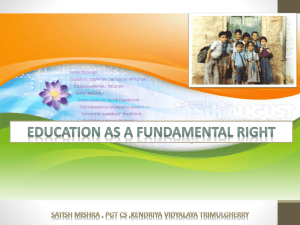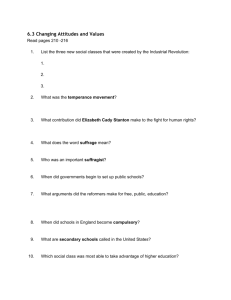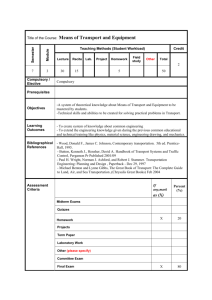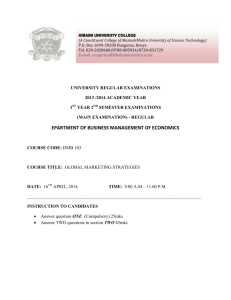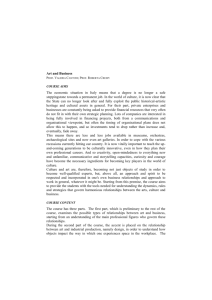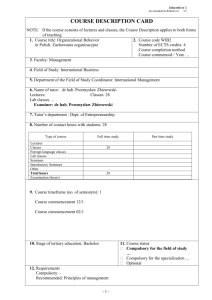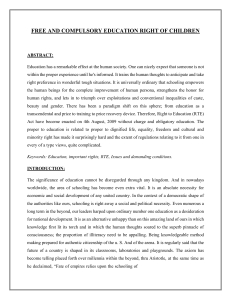'Implementation of RTE' -Centre for Child and the Law, India
advertisement
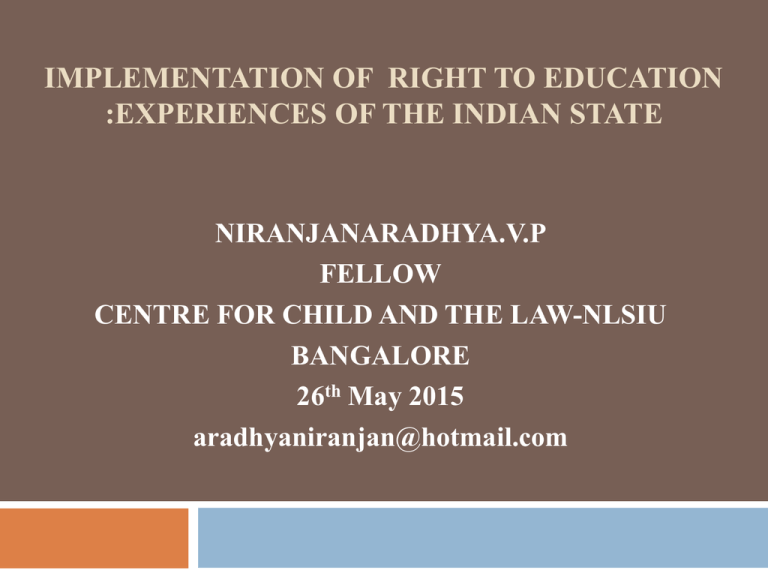
IMPLEMENTATION OF RIGHT TO EDUCATION :EXPERIENCES OF THE INDIAN STATE NIRANJANARADHYA.V.P FELLOW CENTRE FOR CHILD AND THE LAW-NLSIU BANGALORE 26th May 2015 aradhyaniranjan@hotmail.com HISTORICAL CONTEXT Education was denied to masses .It was privilege rather than a right . The demand for RTE (Free and Compulsory Education) was the product of the freedom struggle 1. Charter Act- 1813 2. Education Commission of India (Hunter Commission)-1882 3. F&CE Bill –imperial legislative assembly - 1911 4. Gandhi Proposal(instead of 3Rs -3Hs)-1937 5. Sir Sargent Plan –post war development plan -1944 6. Constituent Assembly and Making the Constitution –Shifted from Justiciable fundamental right to non-justiciable directive principle Niranjanaradhya.V.P-Centre for Child and the Law-NLSIU HISTORICAL CONTEXT Article 45 under Directive Principles: The State shall endeavour to provide, within a period of ten years from the commencement of this Constitution, for free and compulsory education for all children until they complete the age of fourteen years The goal remained elusive by 1960 Than , postponed to 1976-1986-1990-2000-2010 Niranjanaradhya.V.P-Centre for Child and the Law-NLSIU SUPREME COURT VERDICT -1992 The Supreme Court first recognised the right to education as a fundamental right in Mohini Jain v. Union of India 1992 1. 'Right to life' is the compendious expression for all those rights which the courts must enforce because they are basic to the dignified enjoyment of life. 2. The right to life under Article 21 and the dignity of an individual cannot be assured unless it is accompanied by the right to education. 3. The State Government is under an obligation to make endeavor to provide educational facility at all levels to its citizens (para 12) Niranjanaradhya.V.P-Centre for Child and the Law-NLSIU SUPREME COURT VERDICT -1993 In 1993 the Supreme Court narrowed the ambit of the fundamental right to education as propounded in the Mohini Jain case in the case of J P Unnikrishnan vs. State of Andhra Pradesh The right to education which is implicit in the right to life and personal liberty guaranteed by Article 21 must be construed in the light of the directive principles in Part IV of the Constitution. (a) every child/citizen of this country has a right to free education until he completes the age of fourteen years and (b) after a child/citizen completes 14 years, his right to education is circumscribed by the limits of the economic capacity of the state and its development. We may deal with both these limbs separately. (para 171) Niranjanaradhya.V.P-Centre for Child and the Law-NLSIU 86TH CONSTITUTIONAL AMENDMENT -2002 Article 21A: The State shall provide free and compulsory education to all children of the age of six to fourteen years in such manner as the State may, by law, determine Play school and Pre-school is -not compulsory. Primary school- first to fifth standard/class ( six to ten year-olds) free and compulsory Middle school-sixth to eighth standard/class (11-to 14 year) free and compulsory Secondary school: ninth and tenth standard (14 to 16-year -not compulsory Niranjanaradhya.V.P-Centre for Child and the Law-NLSIU 86TH CONSTITUTIONAL AMENDMENT -2002 Language used Fundamental Right is subject to legislation made by State. Cannot question if it is not properly implemented unless judicial activism Dilution of the Right Niranjanaradhya.V.P-Centre for Child and the Law-NLSIU The RCFCEA-2009 The Right of Children to Free and Compulsory Education Act 2009 was the enabling legislation. The RTE Act came into force on April 1, 2010. Niranjanaradhya.V.P-Centre for Child and the Law-NLSIU WHAT IS AVAILABLE UNDER THE ACT 8 years free and compulsory elementary education in neighbourhood school -3(1) Free-no child shall be liable to pay any kind of fee or charges or expenses that prevent child completing EE3(2) Equal Right for Children with Special Needs -3(3) Non-school /dropout children to age appropriate class –with special training -4 Neighbourhood school within three years -6 Niranjanaradhya.V.P-Centre for Child and the Law-NLSIU WHAT IS PROHIBITED UNDER THE ACT No to Capitation -13 No to Screening procedure -13 No to Denial of admission for lack of age proof -14 No Child shall be denied admission at any point of time in the academic year -15 No child shall be held back or expelled -16 No child shall be subjected to physical punishment or mental harassment -17 Niranjanaradhya.V.P-Centre for Child and the Law-NLSIU CURRICULUM AND EVALUATION Conformity with the values enshrined in the Constitution All round development of the child Development of physical and mental abilities to the fullest extent Learning through activities, discovery and exploration in a child friendly and child centred manner Medium of instruction –as far as possible mother tongue Making child free from fear ,trauma and anxiety CCE Niranjanaradhya.V.P-Centre for Child and the Law-NLSIU PROTECTION OF RIGHT NCPCR/SCPCR Examine and review safeguards for rights provided Recommendation measures for effective implementation Inquire into complaints relating to child's right Take necessary steps Local Authority Written compliant to local authority LA shall decide the matter within three months Aggrieved by LA may prefer to appeal to the state commission Niranjanaradhya.V.P-Centre for Child and the Law-NLSIU TIMELINE FOR MEETING THE PRESCRIBED STANDARDS Establishment of NHS 3 years -31st March 2013 Provision of school infrastructure 3 years -31st • All weather buildings March 2013 • Head teacher -cum -office room • Library • Toilets drinking water • Barrier free access • Playground ,fencing boundary walls • One-classroom-one -teacher Niranjanaradhya.V.P-Centre for Child and the Law-NLSIU TIMELINE FOR MEETING THE PRESCRIBED STANDARDS Teachers as per PTR Training of Untrained Teachers Quality interventions • • • • • • • working days primary -200 higher Primary -220 Instructional hours per academic year primary -800 Instructional hours per academic year higher primary -1000 Minimum working hours per week -45 TLM for each class Play material games and sports 31st March 2013 31st March -2015 From immediate effect Niranjanaradhya.V.P-Centre for Child and the Law-NLSIU AT THE END OF 65 YEARS OF INDEPENDENCE AND 5 YEARS OF IMPLEMENTING -RTE The social stratification , inequality, segregation and discriminationremains glaring IB-Oxford-Cambridge International Schools –Elite and Aristocracy ICSE Schools -Rich and Business Class CBSE Schools-KV, Navoday, Army Schools –Bureaucrats –Judges-Politicians Prestigious Private English Medium Schools -Upper Middle Class Low Fee Private English Medium Schools -Middle class Private aided schools-Lower Middle Class Government and Local Authority Schools –Poor Education Guarantee Scheme –Non formal-Flexi schools –Marginalized and Excluded Niranjanaradhya.V.P-Centre for Child and the Law-NLSIU LET US REDEFINE THE GOALS FOR POST 2015 Equal Opportunity- eliminating all forms of exclusion, segregation , inequality and discriminations Minimum 15 percent of the national GDP for RTE Equitable Quality –common minimum standards for quality learning Downward (to cover 0 to 6) and upward (to cover 15 to 18) extension of RTE-to comply with UNCRC Abolition of all forms of Child Labour to align with RTE Education as a social good- Check on privatisation, commercialisation and corporatisation of education Niranjanaradhya.V.P-Centre for Child and the Law-NLSIU TO CONCLUDE Law is an instrument .Justice is its function and its validation. If there is nothing to hope from the law, and if injustice is legalised, insurrection will rise . V.R.Krishna Iyer Former Judge Supreme Court Law Versus Justice: problems and Solutions Niranjanaradhya.V.P-Centre for Child and the Law-NLSIU
